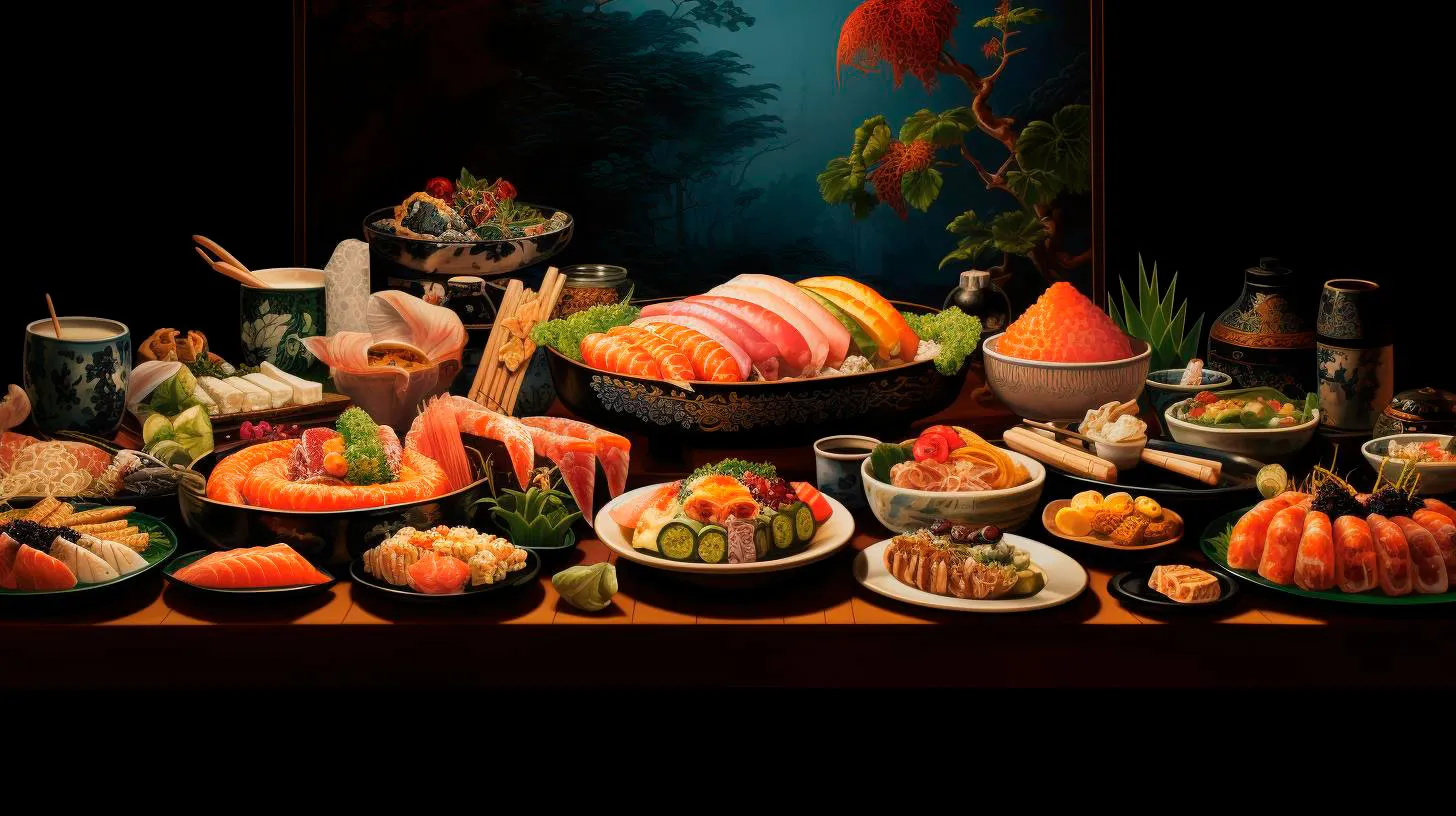Discover fascinating sushi facts in our exciting trivia showdown
In this article, we will embark on an exciting journey to uncover fascinating facts about sushi that will leave you craving for more.
The Origins of Sushi: Delighting Taste Buds for Centuries
Sushi, as we know it today, has a rich history dating back to around the 8th century in Japan. However, its roots can be traced even further, to China in the 2nd century AD. Originally, sushi was created as a preservation method for fish, where the fish was fermented with rice and salt. Over time, this technique evolved, and the rice started to be consumed as well, leading to the development of what we now know as sushi.
Key Takeaway: Sushi has a long history and has evolved from a preservation method to a delicacy enjoyed worldwide.
The Heart and Soul of Sushi: Freshness and Quality
One of the defining characteristics of sushi is the emphasis on freshness. The raw fish used in sushi, known as sashimi, must be incredibly fresh to ensure both safety and taste. In Japan, strict regulations govern the handling and storage of fish to maintain its pristine quality. Sushi chefs take great pride in sourcing the freshest ingredients, and this commitment to quality is what sets sushi apart.
Sushi is also known for its rice, which is carefully seasoned with a mixture of rice vinegar, sugar, and salt. The rice should be slightly sticky, making it easier to shape and hold together. Achieving the perfect balance of flavors in the rice is a skill that sushi chefs hone through years of practice.
Key Takeaway: Freshness is of utmost importance in sushi, both in terms of the fish used and the rice preparation.
Different Types of Sushi: A World of Variety
Sushi is not limited to a single type or preparation method. In fact, there are several variations that cater to different tastes and preferences. Let’s explore some of the most popular types:
- Nigiri: This classic sushi style consists of a small mound of rice topped with a thin slice of raw fish or seafood.
- Maki: Maki sushi is created by wrapping rice and various ingredients in a sheet of seaweed called nori.
- Sashimi: Sashimi refers to thinly sliced raw fish or seafood served without rice.
- Temaki: Also known as a hand roll, temaki is a cone-shaped sushi roll wrapped in nori and filled with rice, fish, and vegetables.
These are just a few examples of the incredible variety found in the world of sushi. Each type offers a unique flavor profile and texture that caters to different preferences.
Key Takeaway: Sushi comes in various forms, allowing diners to explore a wide range of flavors and textures.
Sushi Trivia: Facts That Will Surprise You
Now that we’ve covered the basics, let’s dive into some fun sushi trivia:
- Did you know that the word “sushi” actually refers to the rice used in the dish, not the fish? The term “sashimi” is used to describe the raw fish or seafood.
- The quirky California Roll, a western invention, is believed to be the reason behind sushi’s international popularity. With ingredients like avocado and crab, it appealed to those wary of raw fish.
- The world’s most expensive sushi can be found at the restaurant Sukiyabashi Jiro in Tokyo, where a meal can cost up to $300 per person.
- Sushi is often considered a healthy cuisine choice. It is low in saturated fat and high in omega-3 fatty acids, which are beneficial for heart health.
These fascinating tidbits of knowledge demonstrate the multifaceted nature of sushi and showcase why it continues to captivate people around the globe.
The Cultural Significance: Sushi Beyond the Plate
Sushi holds a significant place in Japanese culture, beyond being a delectable dish. The art of sushi-making is steeped in tradition and requires years of apprenticeship to master. It is not uncommon for sushi chefs to dedicate their entire lives to perfecting their craft.
Additionally, sushi etiquette plays a crucial role in Japanese dining customs. For example, it is considered impolite to mix wasabi into soy sauce, as the chef has already artfully prepared each sushi piece with the ideal amount of wasabi.
Key Takeaway: Sushi represents not only a culinary delight, but also a rich cultural heritage that is deeply respected in Japan.
The Global Sushi Craze: Continuously Evolving
In today’s interconnected world, sushi has become a global phenomenon. Its popularity has soared in the past few decades, with sushi restaurants popping up in major cities across the globe. From small local sushi joints to high-end establishments, the demand for sushi continues to grow.
According to statistics, the global sushi market was valued at over $14 billion in 2020 and is projected to reach $22.9 billion by 2027. This surge in popularity can be attributed to the increasing appreciation for different cultures, the rise of health-conscious dining habits, and the allure of experiencing this culinary art form.
Key Takeaway: Sushi has gone beyond its Japanese origins, captivating taste buds worldwide and driving a thriving global market.
In Conclusion
Sushi has transcended its humble beginnings and become an international culinary sensation. Its fusion of flavors, dedication to freshness and quality, and cultural significance make it a truly captivating experience. Whether you’re a sushi aficionado or new to the world of sushi, we hope this journey through sushi trivia has deepened your appreciation for this extraordinary cuisine.
Are you a sushi connoisseur? Put your skills to the test.
Here are some exciting ideas:
1. Sushi Making Workshops
Joining a sushi making workshop can be a fantastic way to learn the art of sushi from the experts themselves. These workshops are typically conducted by skilled sushi chefs who will teach you how to make different types of sushi rolls, nigiri, and sashimi. You’ll also learn about the different ingredients, techniques, and presentation styles used in sushi making. Not only will you gain hands-on experience, but you’ll also deepen your understanding and appreciation for this culinary craft.
- Learn from skilled sushi chefs
- Create various types of sushi rolls, nigiri, and sashimi
- Get hands-on experience and guidance
- Deepen your understanding of sushi making techniques
2. Sushi Tasting Events
Attending sushi tasting events is a great way to expand your sushi palate and explore new flavors and combinations. These events often feature a wide range of sushi offerings from different restaurants and sushi bars. You can try unique sushi creations, signature rolls, and even experimental sushi dishes. It’s a chance to discover new favorites and learn more about the diverse world of sushi.
- Experience a variety of sushi flavors and combinations
- Sample unique sushi creations and signature rolls
- Discover new sushi restaurants and bars
- Expand your sushi palate
3. Sushi Pairing Experiences
Just like wine, sushi can be paired with different beverages to enhance the dining experience. Sushi pairing experiences allow you to taste sushi alongside various drinks like sake, wine, or even craft beer. These events often feature expert sommeliers or beverage specialists who guide you through the art of pairing sushi with the right drink. It’s an opportunity to explore the harmonious balance of flavors that can be achieved through thoughtful food and drink combinations.
- Learn the art of pairing sushi with different beverages
- Discover the perfect drink to complement your sushi
- Enhance your dining experience
- Appreciate the balance of flavors
4. Sushi Chef Experiences
For those who dream of becoming a sushi chef or want to learn more about the behind-the-scenes world of sushi making, sushi chef experiences offer a unique opportunity. These experiences allow you to shadow a sushi chef, observe their techniques, and even try your hand at sushi making under their guidance. You’ll gain valuable insights into the skills, precision, and dedication required to create sushi masterpieces.
- Shadow a sushi chef and observe their techniques
- Learn about the skills and precision required in sushi making
- Try your hand at sushi making under expert guidance
- Gain valuable insights into the world of sushi chefs
Key Takeaways
Sushi is more than just a meal; it’s a craft that can be explored and appreciated in various ways. By participating in sushi making workshops, attending tasting events, exploring sushi pairing experiences, and immersing yourself in the world of sushi chefs, you can enhance your knowledge, skills, and appreciation for this remarkable cuisine.
So, whether you’re a sushi fanatic looking to deepen your understanding or simply someone who wants to experience sushi in a new way, these activities will surely put your skills to the test. Get ready to indulge in the art of sushi and discover the world beyond raw fish!
Sushi Trivia: How Well Do You Know this Japanese Delicacy?
But how well do you truly know sushi? Let’s find out!
Sushi: An Ancient Culinary Art
Sushi has a rich history that dates back centuries. Originally, it was developed as a method to preserve fish by fermenting it with rice. Over time, sushi evolved into the art form we know today. Here are some interesting facts about sushi:
- Sushi was first mentioned in a Japanese dictionary in the 9th century.
- Traditional sushi chefs train rigorously for years to perfect their craft.
- The most expensive sushi in the world is served at Sukiyabashi Jiro in Tokyo.
- Contrary to popular belief, sushi does not always contain raw fish. Vegetarian options like cucumber, avocado, and egg are just as delicious!
The Sushi Knowledge Challenge
Now, let’s dive into the heart of our sushi knowledge challenge. Get ready to test your expertise with these mind-boggling questions:
1. What does the word “sushi” actually mean?
Sushi enthusiasts should know this one! The term “sushi” refers to seasoned rice combined with various ingredients, often including raw or cooked fish, vegetables, and seaweed.
2. What are the different types of sushi?
Sushi comes in many forms, each offering a unique flavor and texture. Here are some popular types:
- Nigiri: A classic style of sushi consisting of a slice of raw fish placed on a small mound of rice.
- Maki: Sushi rolls wrapped in seaweed (nori) and filled with rice, fish, and vegetables.
- Sashimi: Slices of fresh, raw fish served without rice.
- Temaki: Hand rolls made by wrapping seaweed around a filling of rice, fish, and vegetables.
3. What is the purpose of wasabi with sushi?
Wasabi, a spicy green paste often served with sushi, adds a kick of flavor and heat. However, its main purpose is to kill bacteria present in raw fish, ensuring a safe dining experience.
4. How should sushi be eaten?
Sushi etiquette is essential to fully appreciate this culinary delight. Here are some tips:
- Use chopsticks or your hands, depending on the type of sushi.
- Dip the fish, not the rice, into soy sauce to avoid overpowering the flavors.
- Consume each piece in one bite to experience the perfect balance of ingredients.
Key Takeaways
Now that you’ve taken the sushi knowledge challenge, let’s recap the key takeaways:
- Sushi is more than just raw fish – it encompasses a variety of ingredients and preparations.
- There are different types of sushi, including nigiri, maki, sashimi, and temaki.
- Wasabi serves not only as a flavor enhancer but also as a safety measure against bacteria.
- Savor each sushi piece with proper technique and etiquette for the best culinary experience.
Congratulations on completing the Sushi Knowledge Challenge! Whether you aced it or discovered some new sushi trivia, your expertise in this Japanese delicacy has undoubtedly grown. So, next time you indulge in sushi, savor every bite with a newfound appreciation for its history, variety, and cultural significance.


